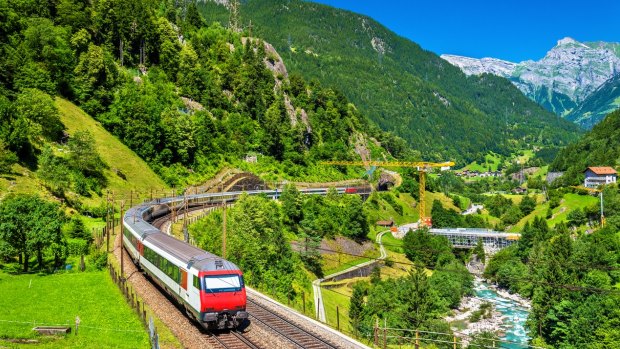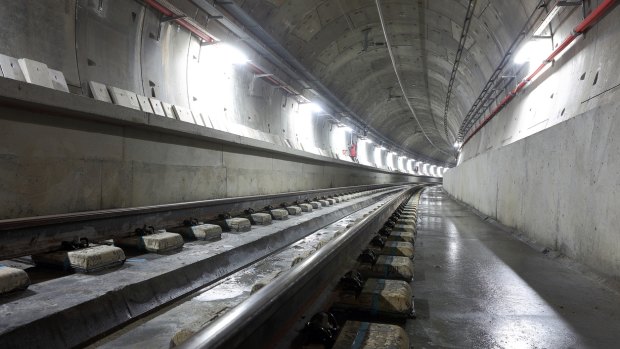This was published 7 years ago
Alternative route to the Gotthard Base Tunnel, Switzerland: The Gotthard Pass and San Gottardo travel tips
By Keith Austin
In the National Museum of the San Gottardo at the very tip of the 2106-metre Gotthard Pass in the heart of Switzerland there is a papier-mache model of the Devil in a sort of Uncle Sam "I Want You" pose. He's wearing blue-and-white striped shorts for some reason and is holding his long tail in a suggestively priapic manner.
I only point this out because it's not something you'll find on the brand new, blue-liveried trains that will flash by two kilometres or more below his feet at speeds of 250km/h in the 57-kilometre-long Gotthard Base Tunnel that officially opened on December 11.
The tunnel, the longest and deepest of its kind in the world, offers yet another reason not to use the severe switchback roads of the Gotthard Pass high above it. This is a pity because it has a story or two to tell – ones that involve our cocky Devil, the Romans and secret World War II tunnels carved out of the rugged mountainsides and only recently revealed to the public.
Before the 1882 opening of the first Gotthard train tunnel, all 15 kilometres of it, the only way to get between the southern, Italian-speaking part of the country and the German-speaking canton of Uri was over the pass, either by walking, horse or, in the latter years before that first tunnel, stagecoach.
There is just such a stagecoach in the museum and as we file in through the entrance our guide points out that in its heyday a trip over the pass would cost the equivalent of 700 francs in today's money. That's about $925 and much the same price as a modern 15-day first-class Swiss Travel Pass. "It was only for the rich," explains the guide.
The museum itself is housed in the old customs house from 1834 and used to double as a rest stop for travellers who had endured the rugged roads up to the pass. Inside it gives a fascinating overview of the history and importance of the pass from economic, strategic, political and cultural points of view. And it has a papier-mache Devil.

An Intercity train on the old Gotthard railway through the spectacular pass in Siwtzerland.Credit: iStock
There is one room that is filled with all the different types of crystals that have been found and sought after – particularly by the Romans – over the years. Avoid it unless you have the hots for anthracite, calcite, malachite, alright and the Dark Knight. At least I think that's what the guide's saying – I've fallen into a bit of a crystal coma.
The Devil, by the way, gets a look in because of a legend about a bunch of villagers who, faced with the difficulty of building a bridge in the inhospitable local conditions, wished that the Devil would do it for them. Dutifully, he appeared but demanded that the soul of the first to cross the bridge belonged to him. The villagers agreed and, after what became known as the Teufelsbrucke (Devil's Bridge) was built, drove a goat across first. No fools, those Swiss.
After lunch at the museum cafe we take a short, cold walk around behind the building to a rise from where we can see the old cobblestone road as it hairpins alarmingly down the hillside, constantly folding back on itself like a piece of discarded string. There is a gentle haze over the landscape and, as we watch, a solitary cyclist appears puffing and pedalling out of the patchy mist.

The underground tunnel is efficient but bleak.Credit: iStock
But it's on the other side of the small plateau, past the car park, the dreary pond and a ramshackle stall selling barbecued bratwurst that things start to get bizarre. For here is where we find the discreet entrance to a secret World War II bunker.
Carved into the hillside and complete with thick steel double doors, the entrance opens up to a long, dark narrow corridor that leads deep into the interior of the mountain. Here, during World War II, units of the Swiss Army manned a hidden redoubt – Fort Sasso da Pigna – carved out of the mountains in case Switzerland got dragged into the conflict.
Among the 2400 metres of atmospheric galleries, tunnels, food stores, funicular and barracks are two single barrelled 15cm guns, complete with shells, their long muzzles poking out of the mountainside and pointed for ever more towards an Italy that never attacked.
The first "fort" was built here in 1894 but the advent of World War II saw the battery enlarged as the country gradually became encircled by Hitler's Germany to the north and Mussolini's Italy to the south.
It's a truly fascinating insight into the geo-politics of the time and how a country as neutral as Switzerland nonetheless prepared itself for war or, at the very least, for a retreat across hostile terrain that would have cost the enemy dearly. Certainly, winkling the Swiss Army out of Sasso da Pigna would have been as hard as tricking Satan out of a soul.
My advice? Take the new train tunnel one way through the Alps but for a true understanding of why such tunnels were necessary in the first place, come back over the Gotthard Pass. It's somewhere between the devil and the deep blue seats.
The writer travelled as a guest of Switzerland Tourism.
See also: Inside the world's longest, deepest train tunnel
See also: Fastest, highest, longest: World record-breaking train journeys
TRIP NOTES
MORE INFORMATION
passosangottardo.ch/en/musei/museo-nazionale.html
discover-the-heart-of-switzerland.ch
AT THE PASS
The National Museum of the San Gottardo and other amenities at the Gotthard Pass are open between June and October 16. During the summer season the museum is open from 9am-6pm. Museum tours are available in Italian, French, German and English.
Fort Sasso da Pigna is open from May 28-October 16, from 10.30am-3pm (last admission). It's open daily in July/August except for Tuesdays; September/October it's open Wednesday-Sunday. Tours take about two hours. For detailed opening times and prices, see discover-the-heart-of-switzerland.ch.
Be aware that the road over the pass is often impassable in winter. Check conditions before travelling.
GETTING THERE
British Airways, Qantas, Swiss and most other major airlines fly to Europe from the main Australian cities. See webjet.com.au.
Sign up for the Traveller Deals newsletter
Get exclusive travel deals delivered straight to your inbox. Sign up now.